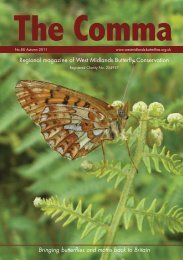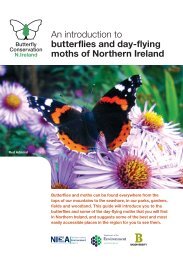EIG newsletter - Butterfly Conservation
EIG newsletter - Butterfly Conservation
EIG newsletter - Butterfly Conservation
Create successful ePaper yourself
Turn your PDF publications into a flip-book with our unique Google optimized e-Paper software.
Butterflies of Hungary<br />
Hungary, justly famous for the variety of its bird life, also has a very rich and exciting<br />
butterfly fauna. This is the first of a series of two articles introducing this diversity and<br />
associated threats.<br />
Where East meets West<br />
After the last ice-ages, butterflies from several (zoogeographical) regions dispersed<br />
into the Carpathian Basin. The expansion of butterflies into Hungary has been<br />
facilitated by a various climate, with both continental, boreal and Mediterranean<br />
influences. As a result, a broad spectrum of familiar and (from a British point of view)<br />
more unknown species occupied the country.<br />
More recently, we have witnessed expansive behaviour of three exciting Hungarian<br />
butterflies. Rather then just summing up Hungarian species we would like to report<br />
these intriguing phenomena. It concerns two true oriental and a Mediterranean<br />
species.<br />
Dispersal of butterflies usually is associated with extreme weather. All over Europe,<br />
2003 was a year with good prevailing conditions for<br />
butterflies. In July, both the Pallas’s Fritillary (a<br />
continental sp.) and the Cardinal (a Mediterranean sp.)<br />
were on the move in Hungary, the Pallas’s westward<br />
and the Cardinal to the North. Both species were<br />
observed outside suitable habitat and far from their<br />
previous occurrence. Despite a few cold and wet<br />
Pallas’ Fritillary (Argyronome laodice)<br />
Photo: Rob de Jong<br />
springs in the subsequent years, they have established<br />
several populations beyond their original borders.<br />
A population of each species settled in a valley in the South-east verges of the Bükk<br />
hills in NE Hungary. The valley has a good population of Corncrakes and is being<br />
managed in a way that the birds are not disturbed during the breeding season. This<br />
management, delaying mowing till late summer, is beneficial for butterflies as well. A<br />
survey in this damp stream-valley, on July 31 in 2006, produced an incredible<br />
number of 68 butterfly species. Striking was the amount of 16 Fritillaries. There were<br />
Dark Green, High Brown, Silver-washed and Marbled Fritillaries. In addition, we<br />
observed Camberwell Beauty, Lesser Purple and Purple Emperor, Large<br />
Tortoiseshell and Common Glider. Scarce Fritillary, Clouded Apollo, Chequered<br />
Skipper and seven other species were observed here earlier in the season. As a<br />
result of the stimulating weather conditions in the summer of 2003, the valley is now<br />
even enriched by Pallas’s and Cardinal.<br />
Another example of what a weather boost can cause is displayed by an invasion of<br />
the Yellow-legged Tortoiseshell. In the third week of June 2006 we had a strong<br />
warm wind from the North-east. On this wind, incredible numbers of this illustrious<br />
butterfly reached Hungary. The authors saw hundreds of animals in the Zemplen hills<br />
and several on the dry plains of Hortobagy, a well known paradise among<br />
birdwatchers. This continental species was thought to be extinct from Hungary, but<br />
recent findings of caterpillars and pupae prove that there is reproduction here.<br />
13







